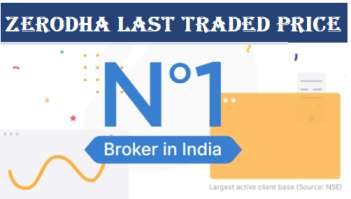An Overview of Zerodha Last Traded Price

With the market fluctuations, shares of the stocks prices are always in movement — rising or falling. No one can decide the stock price or label the price tag on it. So the traders and investors buy the shares when they are willing to pay the bid price and sell them when they think that the stock earns them profit. While the trader buys the stakes and the company sells, the middleman — the stockbroker company makes thru the brokerage and subscription plan they offer to the traders.
The price the traders see for the company’s stocks is the LTP — Last Traded Price. LTP reflects the trade that happens in the past — the rise and fall of the stock prices.
LTP vs. Closing Price
|
Sr. No. |
LTP - Last traded Price |
Closing Price |
|
1. |
LTP is the last price of the transaction executed on the exchange. |
The closing price is calculated as an average price based on the trading carried out in the last 30 mins before the market close. |
|
2. |
LTP is displayed on a percentage basis on the left side of the stock, and the trader can see it on the Zerodha market watch. |
The trader can view the closing price in the market depth section on the Zerodha app. |
|
3. |
LTP showcases the price of the last executed orders at the time of trading hours. |
During the market hours, the closing price displayed in the market depth is the previous day. |
|
4. |
The last stock price is updated at the end of the trading market hours. |
After the trading closed, the final display will be of the closing price. |
|
5. |
LTP executed last at 15:29:59 hrs |
The closing price calculation takes place between 15:30 to 15:40 hrs for the transaction conducted in the last 30 minutes. |
Importance of LTP
LTP helps in understanding the stock nature and the market condition of the stock. For instance, if the price of Indigo shares is 1123, the trader places the order for 1100 because, as per the LTP, the price is expected to fall, hence the better deal.
The market in-depth in Zerodha shows the history of the stock and the prices at which it was traded recently. In addition, the stock's LTP information helps the trader decided to purchase or sell the stocks.
Bid Price, Asking Price & Last Traded Price
The Bid Price is the highest price the trader is ready to pay to buy the stocks. For instance, a trader ordered the stocks to the share broker and offered to buy the stocks in significant volume. Thus, the highest proposed buying stock price is the bid price, which signifies the demand for the stock in the market.
The Asking Price refers to the price the trader is ready to sell the stocks for. Therefore, the buyer needs to know how much the seller is willing to go lower to sell the stocks. The seller of the stocks ready to sell the stocks at the lowest price among all proposed prices is the Asking Price. The lowest price offered describes the more supply of the stock in the market.
LTP — Last Traded Price is decided by the demand and supply of the stock, and it is the last price that the buyer and seller traded before the stock market close at 15:29:59 hrs.
Conclusion
Investing in stock takes a lot of practice to understand how the stock market works, as many things need to be considered. Therefore, it is highly advisable to perform a deep market analysis before investing in a large volume.
Frequently Asked Questions:
-
1. What is Zerodha LTP?
LTP is a stock's Last Traded Price, the final rate the order gets executed on the exchange. LTP helps the traders study the stock price of previous days and weeks and predict the stock price in the future. The last traded price helps the trader to determine whether to purchase or sell the stocks.
-
2. What is the LTP percentage in Zerodha?
The LTP in Zerodha shows in percentile, and the percentage indicates the stock movement from the previous day. In addition, the Zerodha app offers the users an additional LTP feature where they can view the stock LTP value from its opening market price.
To view the opening price LTP, the trader needs to click the bottom setting icon of the Market Watch screen on the Zerodha app and click on “open price” under the change option.
-
3. How do you find the Last traded Price in Zerodha?
LTP in Zerodha indicates in percentage — the percent of the stock movement of the previous day, and the trader can view the LTP for the stocks in their detailed history.
For instance, if the trader adds any stock company on the market watch list for BSE and NSE, the trader can view a percentage value on the left side of the stock price. The red color of percentage indicates that the current LTP is lower than yesterday’s LTP, and the green color indicates that the present LTP has more value than the current one.
Example 1: Axis Bank price shows 811, and there is a green icon of 0.23% — it means that the stock price is 0.23% up from yesterday’s closing price.
Example 2: Reliance Communication price is showing 798, and there is a red icon of 0.06% — it means that the stock price is 0.06% lower from yesterday’s closing price.
-
4. What is the Last Price of Futures Contracts?
A future contact in the stock market refers to an agreement by the trader to the seller to buy the stocks or commodity in future decided date at a predetermined rate. The future contracts expedite the trading on the future order exchange. The trader is obliged to buy the stocks when the future contract expires.
The last price of the futures contracts will be the stock price on that particular day before the stock market close.
-
5. What is Market Price?
The market price refers to the cost of the stock sold on the trading market in the stock market. The market price tends to fluctuate throughout the trading time — 09:15 hrs to 15:30 hrs. The stock's market price goes up when more traders buy the stocks, and the price falls when more traders begin to sell their stocks. The market price is not the final price that indicates the value of the stock.



0 Comments